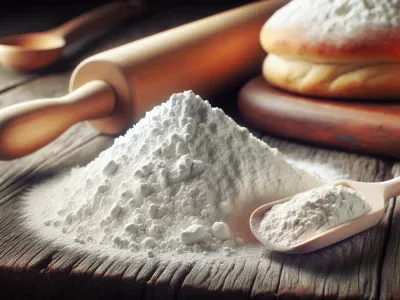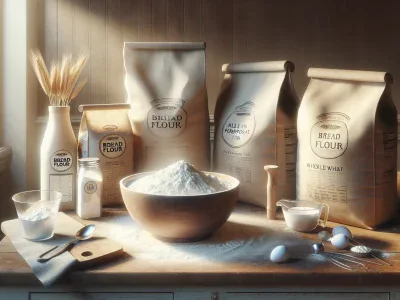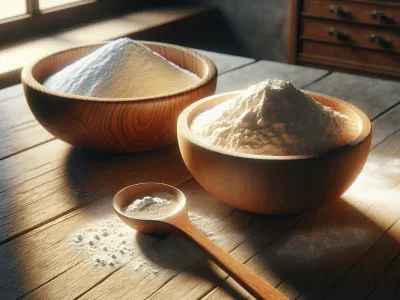Difference Between Bread Flour and All‑Purpose Flour: Which Is Best for Your Baking?
Picture the aroma of fresh bread wafting through your kitchen—crisp crust crackling as you slice through a loaf still warm from the oven. But what if the secret to that perfect rise and chewy texture lies hidden in the bag of flour you choose? The world of baking is full of small decisions that make a big difference and none is more crucial than picking between bread flour and all-purpose flour.
You might think flour is just flour but the truth is much more intriguing. Subtle differences in protein content and structure can transform your baking from ordinary to extraordinary. Unlocking these secrets not only elevates your homemade bread but also opens up a world of textures and flavors you never knew you were missing. Which flour will give your next loaf that irresistible bite? Let’s unravel the mystery together.
What Is Bread Flour?
Bread flour means flour designed for bread, simple as that. Crafted from hard wheat varieties, it pack a punch with protein content—usually around 12–14%. If you touch bread flour, you notice its granules feel slightly coarser than the soft, pillowy texture of cake flour. It’s like the reliable workhorse in your kitchen—built for structure, heft, and resilience. Now picture biting into a baguette that crackles under your teeth or feeling a pizza crust with a chewy stretch. That magic? It owes a lot to bread flour’s robust gluten network.
Gluten development is central here. When you add water and knead, glutenin and gliadin proteins lock arms, creating long elastic chains. This process trap gases, which means your dough rises tall and airy. That’s why classic artisan breads and sourdoughs demand bread flour. Scientific evidence from “The Science of Good Cooking” (Cook’s Illustrated, 2012) shows loaves using higher protein flour supports more open crumbs and higher volume.
Ask yourself: Have you ever struggled with flat, dense homemade loaves? Many bakers accidentally blame yeast, when bread flour’s power, or lack of it, might be culprit. Contrasted with all-purpose flour, which fills many roles, bread flour is like a specialist—tailored for when you want serious lift, chew, and crispness. Even some experienced bakers get surprised at how a simple switch in flour transforms their baguette, pizza, or focaccia.
Are all bread flours the same? Not exactly. Some brands enriched with malted barley flour or added ascorbic acid to boost yeast activity and dough strength (King Arthur Baking Company, 2023). If you’re shopping, look for protein content listed right on the label—anything above 12% gets you into the bread flour category.
Ever tried substituting bread flour in recipes like cinnamon rolls or dinner rolls? The texture shifts—denser, chewier, less crumbly. That’s the bread flour effect. Whether with sourdough starters or sandwich breads, you’re wielding a tool that amplifies volume, chew, and strength, perfectly tuned for yeast-leavened creations.
What Is All-Purpose Flour?
All-purpose flour, categorized as a versatile wheat flour, gets milled from a mix of hard and soft wheat varieties. You might’ve noticed how it’s the chameleon of your pantry; this flour works in cakes, cookies, crusts, biscuits, and gravy. It contains 10%–12% protein, which creates moderate gluten elasticity—think about soft sandwich loaves, pancakes, or pie dough that don’t demand the springiness of high-gluten bread flour.
You’ll see all-purpose flour compared to a Swiss Army knife: it handles many baking tasks but doesn’t specialize in any. Bakers choose it when they desire balance, not extremes. If you had to whip up chocolate chip cookies or cornbread with the same bag of flour you just used for muffins, that’s all-purpose flour quietly excelling. Have you ever made banana bread and wondered why it’s tender, not chewy? That’s the lower protein at work.
Refined and usually bleached or unbleached, all-purpose flour provides a neutral canvas, which is an advantage when you want flavors like vanilla or brown butter to shine. Some brands, such as King Arthur or Gold Medal, disclose protein content right on the bag—a tip for the curious home baker wanting control over texture. Do you sometimes wonder why grandma’s biscuits melt in your mouth, while rustic European loaves have a chew—protein content, absorption, and gluten development guide that result.
If you dabble in gluten-free baking or ancient grains—oat, spelt, or buckwheat—all-purpose wheat flour remains the commercial and home kitchen standard for “everyday” bakes. According to the USDA, most all-purpose flour is fortified with iron and B vitamins. So, when you measure your fluffy white scoop of flour, you’re not just adding structure, but also, unexpectedly, those nutritional boosts.
Key Differences Between Bread Flour and All-Purpose Flour
Bread flour and all-purpose flour create distinct results in your kitchen. Knowing specific differences helps you control the rise, texture, and structure of what you bake.
Protein Content
Protein content separates bread flour from all-purpose flour in gluten development. Bread flour averages 12–14% protein, with King Arthur’s White Bread Flour listing 12.7% (King Arthur Baking Company). All-purpose flour hovers around 10–12%, eg., Gold Medal’s All-Purpose at 10.5%. Higher protein means greater gluten potential—which, for you, means a chewier crumb and taller rise. Swap one for the other, and even a seasoned baker gets surprised. Have you noticed your cinnamon rolls sometimes too tender, lacking that bakery-style chew? That’s protein at work—or missing. Bakers often joke that switching flour is like switching gears, but your bread dough doesn’t speak in metaphors; it rises, or it doesn’t.
| Flour Type | Protein Content (%) |
|---|---|
| Bread Flour | 12–14 |
| All-Purpose Flour | 10–12 |
Texture and Gluten Development
Texture and gluten development show most dramatically in the finished loaf. Bread flour lets you knead, shape, and coax strong gluten strands—notice that springy, elastic dough resisting your touch? Chewy baguettes, focaccia, sourdough: all rely on robust gluten networks that trap carbon dioxide bubbles. All-purpose flour, meanwhile, builds a softer gluten matrix, great for tender muffins or cookies with a gentle bite. If you’ve ever baked sandwich bread that crumbles instead of flexing, chances are you grabbed the wrong bag. The gluten potential invites you to experiment: try using all-purpose in a classic bagel recipe, and you’ll see a flat, soft result, not the toothsome chew New Yorkers praise.
Usage in Baking
Usage in baking influences every recipe you try. Bread flour fits recipes demanding sturdy structure—think baguettes, pizza crusts, or anything with a dramatic oven spring. All-purpose flour acts as your multitasker, handling pancakes, brownies, biscuits—items where tenderness or moderate structure matters. Professional bakeries in San Francisco—famous for sourdough—choose high-protein flours to get that signature open crumb, while home bakers crafting sugar cookies use all-purpose for delicate, melt-in-your-mouth texture. Curious bakers sometimes mix flours, seeking a middle ground for extra flavor or specific crumb density. The choice between bread and all-purpose flour sets the tone before you even add yeast or sugar. If you crave structured loaves and chewy buns, grab bread flour. Seek versatility, and all-purpose flour never disappoints.
How Each Flour Affects Your Baking Results
Bread flour changes your loaf’s architecture the way steel beams shape skyscrapers. With a protein content of 12–14%, bread flour acts as the backbone for yeast doughs like artisan loaves, bagels, and pizza crusts. Gluten developers, like you, notice that bread flour’s robust gluten formation traps carbon dioxide bubbles, making dough rise tall and springy. Picture the open crumb of a fresh sourdough, with chewy, golden crust—the tactile result of true bread flour at work. When you knead this dough, it fights back, stretching and resisting, a signal of high gluten elasticity. That is not something all-purpose flour can mimic, and you might discover dense centers in cinnamon rolls or focaccia if you swap it in.
All-purpose flour, by contrast, acts like a multitasking sous chef, stepping in for everything from flaky pie crusts to soft banana bread. Its protein content, falling between 10–12%, means it produces less gluten than bread flour. That moderation brings a soft, cake-like crumb in cupcakes and pancakes, a delicate break in a batch of sugar cookies. why biscuits rise flaky and not rubbery? It’s this reduced gluten potential in all-purpose flour. This flour’s flexibility means you can whip up pancakes with tender middles or chocolate chip cookies with crisp edges, all with a single bag.
Some bakers, like James Beard Foundation Award-winner Joanne Chang, argue that using bread flour in a cookie recipe creates a chewier bite, while others stick to all-purpose for wider spread and tenderness (see: “Cook’s Illustrated,” 2023). Which texture do you chase—the satisfyingly robust chew or the featherlight crumb? That’s the silent question every flour bag asks.
Swapping these flours sometimes seems like a harmless experiment, but the outcome often surprises. Try using all-purpose flour in a no-knead artisan bread, and the loaf will slouch, not quite able to hold lofty pockets of air. Toggle the other way—bread flour in muffins—and you greet a tough crumb, where crumb structure overshadows sweetness.
Mixing up your flour isn’t just a substitution; it’s a shift in the structure, in the sensory experience. The protein matrix acts as the architect of rise and texture, mediated by glutenin and gliadin strands unfurling and linking under hydration. Could bread flour ever make a feather-soft birthday cake? Not really; its muscle overshadows finesse. Yet if you want a sandwich bread with height and chew, all-purpose won’t quite get you there.
The best advice comes down to matching your recipe with its true flour soulmate. Next time, look at your recipe—does it sing for strength or does it crave tenderness? Follow the call, and watch your baking transform.
Which Flour Should You Use?
Every loaf starts with a decision, your hands hovering over those familiar sacks at the grocery—bread flour or all-purpose flour. You’ve probably wondered: Is there really that much difference? When flour types drive your baking results, the answer matters.
Bread flour, acting as the backbone of rustic baguettes and mile-high brioche, shines when a chewy crumb and high loft impress is what you’re aiming for. Think of French bakers in bustling Parisian boulangeries counting on the 13% protein content in their flour (King Arthur Baking Company) to capture airy tunnels and crisp crusts. Whenever you’re crafting pizza dough that stretches without tearing, you’re holding the legacy of bread flour’s gluten-building might in your hands.
All-purpose flour, meanwhile, lends itself to flexibility—no fences, just open fields. Consider American home bakers in bustling kitchens, whipping up buttermilk pancakes that melt on the tongue or birthday cupcakes crowned with bright buttercream. The protein range here hovers near 11%, striking a goldilocks balance—soft enough for cakes, sturdy enough for rustic loaves that don’t need an artisan’s touch. Have you ever tossed together biscuits on a Sunday morning, marveling at the tender results? That’s all-purpose flour’s mellow gluten web at work.
Actionable tip: Match flour to project. If you want a bagel’s dense chew or sourdough’s open structure, grab bread flour. If you’re aiming for brownies or shortbread, reach for all-purpose. Swapping them isn’t usually disaster, but a pie crust from bread flour gets tough, while a sandwich loaf from all-purpose might turn a bit squat.
Real-world context echoes this advice. Professional chefs like Claire Saffitz rely on bread flour for focaccia with towering bubbles (New York Times Cooking). Casual bakers—including those featured by America’s Test Kitchen—prefer all-purpose for cookies with a consistent, soft bite.
Are you feeling adventurous? Blend flours for a signature touch. Combining 50% bread flour with 50% all-purpose in cinnamon rolls produces a pillowy interior and sturdy exterior. Or ask yourself: what’s the texture you crave? Let that guide your hand.
Some would say, flour is just ground wheat. But your bakery down the street proves otherwise. Next time you bake, experiment with flours—explore how each changes your breads and sweets. Experience often opens new doors in the kitchen.
Conclusion
Choosing between bread flour and all-purpose flour can make a real difference in your baking results. By understanding the unique properties of each type, you’re better equipped to create everything from chewy artisan loaves to tender cookies and cakes.
Don’t be afraid to experiment with different flours and see how they impact your favorite recipes. The right flour choice lets you unlock new textures and flavors, helping you bake with more confidence and creativity every time you step into the kitchen.
- Which Is Best: Computer Science or Information Technology? - November 12, 2025
- Airbnb Pros and Cons - November 12, 2025
- Rye Versus Bourbon: Understanding the Key Differences - November 12, 2025







